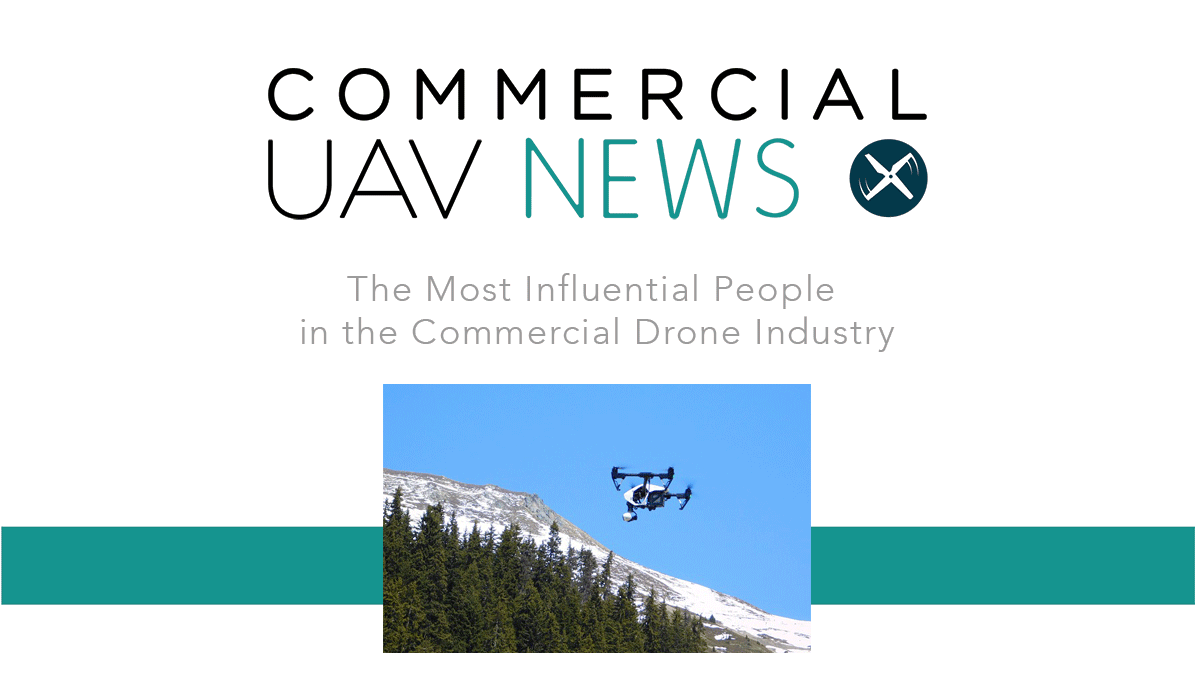 There are countless people who have helped get the commercial drone industry where it is today. Our attempt to highlight some of the people who have been an essential part of this effort is not comprehensive, but instead designed to showcase the variety of interests and influences that are defining what it means to utilize drone technology in an effective and profitable manner. We’re looking forward to finding out who else should and will be part of this list in the coming months and years.
There are countless people who have helped get the commercial drone industry where it is today. Our attempt to highlight some of the people who have been an essential part of this effort is not comprehensive, but instead designed to showcase the variety of interests and influences that are defining what it means to utilize drone technology in an effective and profitable manner. We’re looking forward to finding out who else should and will be part of this list in the coming months and years.
Part 3 of our list, which has not been arranged in any particular order, is below. If you think we’ve missed out on someone feel free to get in touch or discover the sort of insights these folks and plenty more will be looking to share at upcoming industry events.
Part 1 - Part 2 - Part 3 - Part 4
 Chad Colby
Chad Colby
Who is he?
Chad Colby is one of the most sought-after agricultural technology experts in the world. Chad is the founder and principal of Colby AgTech, where he works with progressive farmers, leading companies and government agencies to provide deeper understanding of new technology and recommendations on its practical applications.
Why is he on our list?
To date, Chad has provided information and demonstrations at a majority of U.S. agribusiness company and organization meetings, presented at hundreds of conferences and meetings. He is well known for his industry-leading work as an advocate for commercial unmanned aerial system use in agriculture. He’s laid out in plain detail how to put drones to work on the farm and has shared his insight with various publications, including our own.
What to look out for?
Chad’s frequent and informative updates on Twitter showcase his efforts to help farmers across the world figure out how they can be leveraging drone technology. He also has an active YouTube channel, where you’ll find videos that provide viewers with a real sense of what it means to utilize the latest technology on the farm.
Follow him on Twitter: @TheChadColby
 Anil Nanduri
Anil Nanduri
Who is he?
Anil Nanduri is the Vice President in the New Technology Group and General Manager of the UAV segment at Intel Corporation. He started working with Intel in 1997, and has had many important roles related with chip design, platform enabling, and technical and product marketing since then. His contributions to Intel’s mobile platforms have earned him three Intel Achievement Awards, and he was also responsible for new business opportunities for Intel RealSense technology.
Why is he on our list?
Anil has delivered keynotes at various industry events where he talked through Intel’s vision for this market as well as the technologies and collaborative approaches that will be key for mass use of commercial drones. He is now responsible for establishing and growing Intel’s name in the drone industry, which is a considerable effort. Intel’s influence in the space extends from their light shows all the way to products like the Falcon 8+ System. With the creation of a web page dedicated to drones and CEO Brian Krzanich’s presentation at XPONENTIAL, there’s little doubt of the company’s commitment to and influence in this space. Anil has also taken part in the demonstration of an aircraft visual inspection with a modified AscTec Falcon 8 with Intel RealSense camera, and his participation on the FAA’s Micro UAS Aviation Rulemaking Committee further demonstrate his involvement and dedication to the industry.
What to look out for?
Anil has shared his opinion on how security is a critical point for the future of drones, as well as computer vision and artificial intelligence, which help make drones easier and safer to fly. He also helped us explore what role drones will play in the refinement of data, which was a key aspect of Krzanich’s presentation. Intel will continue to enhance and build more safety features with RealSense, and bring flight planning algorithms and software, automatic tools for seamless integration of flight planning capabilities to all of its drones.
He is also working on releasing the Intel Falcon 8+ as well as a new fixed wing product.
Follow him on Twitter: @nanduri_anil
 Jeremy Wigmore
Jeremy Wigmore
Who is he?
Jeremy Wigmore is CEO of Aerialtronics, a manufacturer of high performance multirotor aerial platforms. Before becoming Aerialtronics’ CEO, Jeremy was the Senior Vice President of Sales. His key responsibilities were managing the sales and coordinating the continued development of strategic reseller and supplier relationships to ensure accessibility for Aerialtronics clientele globally. That focus has helped transform the company into one that’s leading the effort to see AI-powered drones do everything from perform inspection work to survey disaster sites.
Why is he on our list?
Aerialtronics launched its third generation system, the Altura Zenith, back in 2014. By collecting aerial data and processing it into valuable information, the Zenith platform gives clients insights into making smart business decisions. It’s a high performance-flying server that records, processes and transmits data back to the cloud where analytics turn it into actionable information.
In 2016, Aerialtronics worked with NVIDIA and Neurala to develop a AI-powered drone for inspections, and released the first commercial drones featuring cognitive computing capabilities from the IBM Watson Internet of Things (IoT) Platform on IBM Cloud. More recently, at the Commercial UAV Expo Europe, Aerialtronics released a fully integrated computer vision platform with deep learning capabilities, PENSAR.
What to look out for?
With the release of PENSAR, and its work with Artificial Intelligence platforms, Aerialtronics is a company to keep an eye on. Their technologies are being designed to natively work with drones to ensure professionals are able to utilize them and integrate them into their current ecosystem. Such efforts will be a key factor for professionals in various industries as they consider drone adoption.
Follow him on Twitter: @JezzaWigmore
 PK (Parimal Kopardekar)
PK (Parimal Kopardekar)
Who is he?
Parimal Kopardekar (PK) is NASA’s Safe Autonomous System Operations Project Manager, and is tasked with the development of autonomy related concepts, technologies and architectures that will increase efficiency, safety, and capacity of airspace operations. He is at the forefront of NASA’s efforts to develop and define a drone traffic management system, commonly known as a UTM (UAS Traffic Management.) PK has received numerous NASA awards including Outstanding Leadership Medal and Engineer of the Year.
Why is he on our list?
PK has initiated many innovative research projects at NASA. These include: reduced crew operations; net-enabled air traffic management; autonomy for airspace operations; Shadow-Mode Assessment using Realistic Technologies for the National Airspace System (SMART NAS); and low-altitude airspace management system focused on Unmanned Aircraft Systems (UAS) operations.
NASA has had an important role with the latter through the development of the UTM concept, and by working closely together with the FAA to understand what a drone is and isn’t capable of when in the airspace, these efforts can be arguably be seen as his most notable work in the drone industry. The latest tests, completed in October 2016, have been focusing on beyond visual line-of-sight (BVLOS) operations, which is a concept that many in this space are pushing to see developed. The development of some kind of UAS traffic management system is something that operators from across the world are working to define, and PK has taken an active role in those conversations.
What to look out for?
Although the October 2016 tests were completed, NASA is now analyzing results with the FAA,. Those results will impact the next test phase, which is set for January 2018. This phase will focus on testing technologies that maintain safe spacing between cooperative (responsive) and non-cooperative (non-responsive) UAS over moderately populated areas.
PK said: “The plan is, with the research transition team between FAA and NASA, that it all gets implemented and instituted into the operations from FAA's side. We still haven't finished the research yet. This is the last and final leg that I'm describing, which will happen around 2019-2020.”
Follow him on Twitter: @nasapk
 Lewis Graham
Lewis Graham
Who is he?
Lewis Graham is the President and Chief Technical Officer of the GeoCue Group, a group of companies whose focus is sensor processing workflow management, point cloud exploitation and small UAS mapping systems. Lewis holds degrees in Physics and Electrical Engineering, and has experience with earth imaging tools from his time as Z/I Imaging Corporation’s CEO. His expertise in this area has been on display at various industry events where he's discussed topics such as how drone mapping will impact the LiDAR market.
Why is he on our list?
In the past three years, Lewis has worked with AirGon LLC, the Unmanned Aerial Systems (sUAS) subsidiary of the GeoCue Group, developing technology to implement and improve drones’ high accuracy surface mine, industrial and construction site mapping. Together with AirGon, Lewis’ focus is on four major areas: hardware for RTK/PPK grade geopositioning (the AirGon Sensor Package); Reckon, the company’s Amazon Web Services (AWS)-hosted data management and delivery portal; workflow best practices for project repeatability; and production services for customers who do not want to do their own processing.
The result is the “Bring your own drone (BYOD) Mapping Kit”, which includes everything you need to perform local area mapping, and works with a user supplied low cost drone, such as the Phantom or Inspire.
What to look out for?
Lewis will continue to improve the BYOD Mapping Kit, develop new and more efficient solutions, as well as expanding the company’s business, but it’s his efforts to explain how and why drones should be thought of as just another tool that could prove to be most significant. He’s also defined what it means to look at aerial surveying with a drone instead of arguing about photogrammetry vs LiDAR, which has helped shape the conversation about what technology needs to be used in a given situation in a much more effective manner.
 George Mathew
George Mathew
Who is he?
George Mathew is the CEO of Kespry, a developer of automated drone systems with a focus on making it easy to capture, process, use and share high resolution information from the field. Previous to his role in Kespry, George was the President & COO of Alteryx, a self-service Data Analytics company. His achievements within the company include raising $60M in Series B (2014) and $85M in Series C (2015) capital. He is leading the team that is looking to transform the company from a drone company into a data company.
Why is he on our list?
Since George joined Kespry, he has been part of different important events for the company. These include the partnership between Kespry and John Deere which is designed to provide construction professionals with an easy to use drone solution as well as Kespry's entry into the insurance sector, which led to a new relationship with the Catastrophe Response Unit Adjusters (CRU Group).
George was also a key part of a meeting in the White House between various drone industry CEOs and President Donald Trump, to discuss drone laws and regulations. Apart from being the first person to bring a drone into the White House, George was able to point out the safety features and explain some of the drone’s uses.
What to look out for?
We've talked with George about what it means for him to be able to offer his customers an integrated end-to-end drone solution, and it's a topic Kespry is committed to in numerous ways. George wants to keep focusing on delivering a consistent, reliable, autonomous experience, and innovating across the entire continuum - hardware, software, data processing, applications, and APIs - while providing customers with what they need.
Follow him on Twitter: @gkm1
 Kay Wackwitz
Kay Wackwitz
Who is he?
Kay Wackwitz is Drone Industry Insight’s (DRONEII) CEO and Co-Founder, a market research company for commercial drones. He has a degree in aeronautical engineering and more than 18 years of experience in manned and unmanned aviation.
Why is he on our list?
With DRONEII, Kay is able to provide in-depth knowledge of many different topics within the drone industry, and tries to provide a big portfolio of insights, even though most of the company’s research is on-demand and customer specific. He invites everyone with a specific question to reach out and to share its comprehensive view on the drone market to get a better understanding of various industry dynamics and perspectives.
What to look out for?
At Commercial UAV Europe, Kay’s co-founder Hendrik Boedecker explored which commercial market sectors offer greatest potential for use of UAVs, but also helped define what “actionable information” means. These are the sorts of discussions that Kay has and is continuing to have with stakeholders across the globe, and they’ll help define what it means to take advantage of the opportunities that the market is presenting for operators and stakeholders.
Follow him on Twitter: @droneii
Part 1 - Part 2 - Part 3 - Part 4




.png.small.400x400.png)











Comments